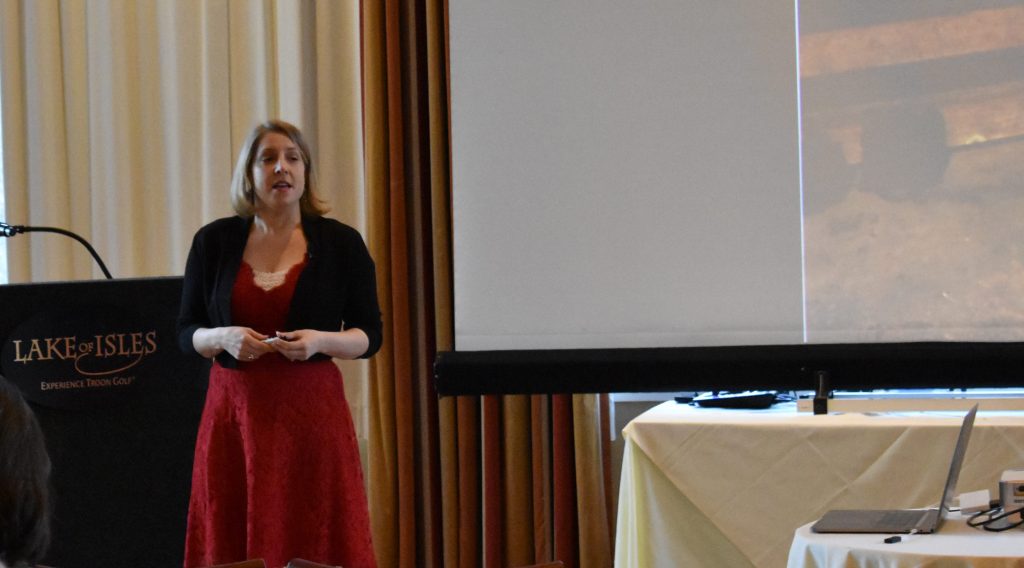Nicole Kear: When Losing Vision, Carpe Diem?
Nicole Kear faked it for a long time.
On a romantic getaway, as her boyfriend gazed at the starlit sky, she gazed at the vast darkness. Same with the twinkling lights at the tip of New York’s Staten Island.
“I was 19 years old when I discovered I couldn’t see stars.”
That’s when the actress and future author received her diagnosis of Retinitis Pigmentosa (RP), a rare, debilitating retinal disease. Her photo receptors were dying; no treatment, no cure.
Author of the memoir “Now I See You,” Kear told her story at “A Rare Opportunity” presented by Sofia Sees Hope, a global advocacy organization for the Leber congenital amaurosis (LCA) patient community and for those with other rare inherited retinal diseases (IRDs), such as RP.
Hearing she’d lose her vision by age 30 came as “absolute blindsiding news.”
Kear shared her story with more than 100 people gathered at Lake of Isles in North Stonington, CT, on March 30. Sofia Sees Hope Co-Founder Laura Manfre characterized the event – which also included a panel discussion – as “a chance to hear from incredible people who have faced head-on an almost unimaginable challenge and chosen hope over defeat.”
Kear felt incredulous at her diagnosis.
She’d always chalked up any stumbles in life to being accident prone, or “I thought I was some airhead who didn’t pay attention.”
She had plans: She was going to be a star of the stage, fall in love, get married, have children.
“Nowhere in these plans was room for losing my vision by 30.”
A River Called Denial
Upon her diagnosis, Kear did what a lot of people might not have expected: “I decided not to think about it.”
Plus, she thought, by the time she turned 30, “I would be ancient by then.”
She learned to drive, kind of. Kear didn’t need a car in New York, but when she temporarily moved to Los Angeles for acting, only three days passed before she realized she’d made a colossal mistake. She drove anyway, with her idiosyncratic driving posture, prompting her sister to tell her maybe she should lean back a little, an exchange recounted in her book:
“What are you talking about?” I snapped, concentrating on my left turn.
“You don’t notice how close your face is to the windshield?”
It was true. My nose was almost touching the glass, my chest nearly pressing the wheel …
“There’s no law about sitting too close to the windshield,” I shot back. “Just sit back and enjoy the ride.”
I couldn’t see my sister’s face, but I bet she looked like she was enjoying the ride about as much as a turn on the Tilt-A-Whirl with a stomach full of corn dogs …
My uncool driving notwithstanding, I did a decent job of getting from point A to point B without dying or killing anyone. In general.
Kear fared better in restaurants than on the road. She learned to order the Caesar salad because it’s usually on the menu she couldn’t see, and she’d ditto her dining partner’s choice for the main course.
She traveled to Paris and London. She enrolled in the San Francisco School of Circus Arts where she learned to be a contortionist and earned a red nose.
“Following every rainbow, climbing every mountain,” Kear told her audience, until she finally gave up the ruse.
‘Anything Is Possible’
“I had realized that my vision had an expiration date … I could carpe diem as much as I wanted, but I had to reckon with my vision loss.”
At 33, after falling in love, marrying and having two of her three children, she faced her diagnosis and reached out to New York’s services for the blind.
The gravity of support and resources empowered her, connecting her to visually impaired people around the world.
“I know now that anything is possible.”
Kear ended her presentation by reading one of the tips that accompany each chapter of her book.
Tip #18: On glass doors. Walk into a glass door once, shame on the door. Walk into it twice, shame on you. Walk into it three times, get yourself a (*%&#*) game plan.

